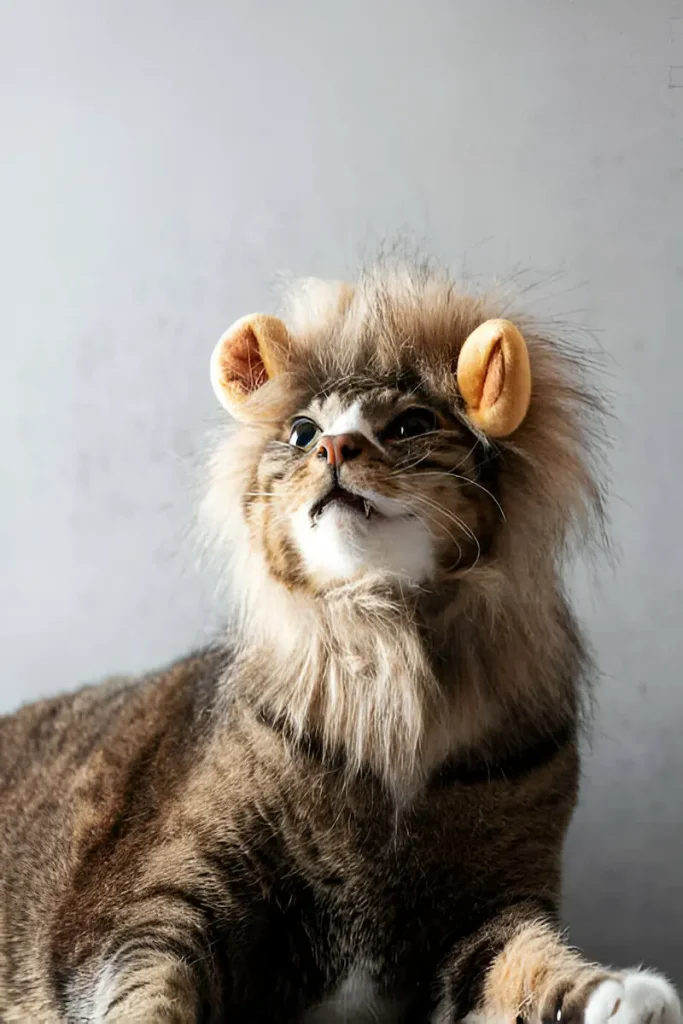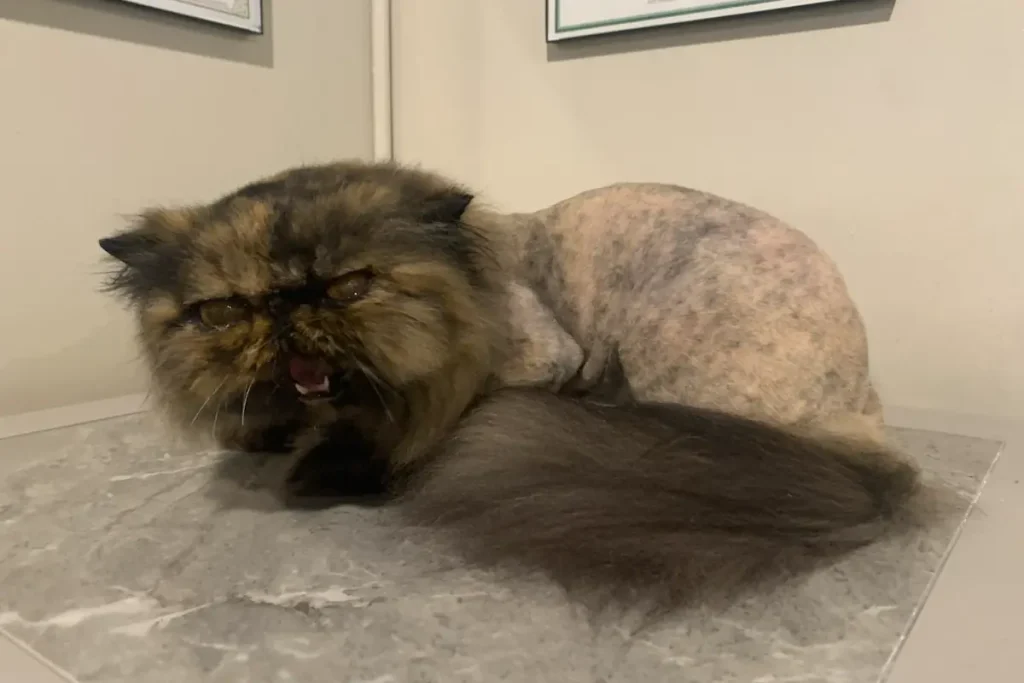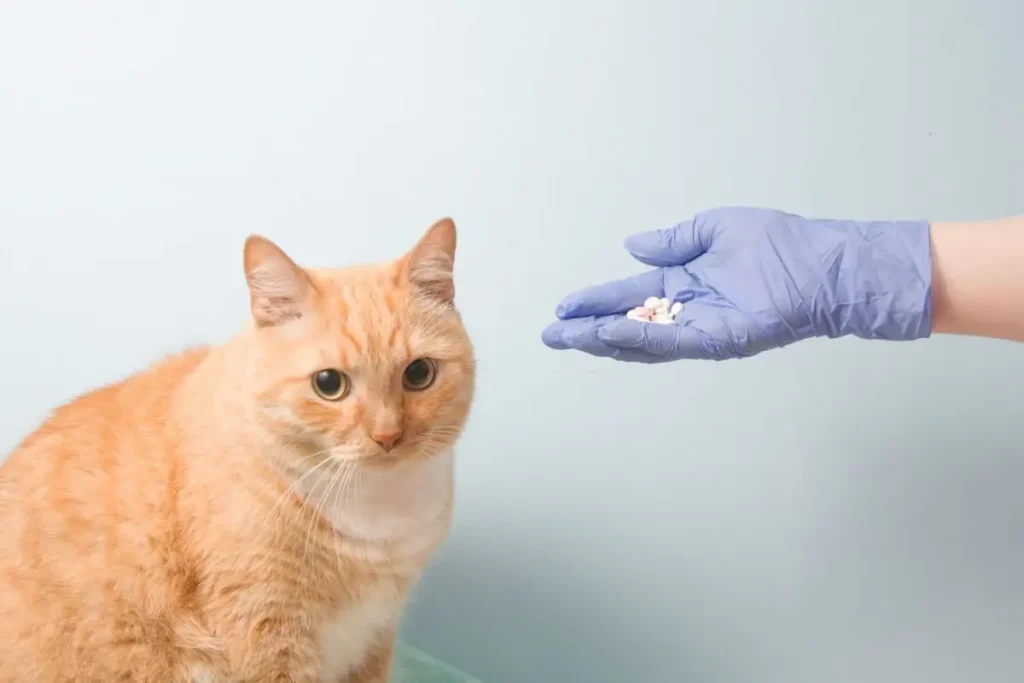Lion Cut For Cats: Pet owners can request variations on this theme. For example, some choose not to clip the tail or clip the neck and chest more, leaving a shorter mane.
Many pet owners report that their cats seem happier and more playful after a lion trim, and this fact alone ensures that they return to appointments regularly. Do you think your cat could benefit from a Lion cut? Read on to learn some pros and cons of this trendy gear.
cat grooming lion cut

The Leo cut consists of a shortcut from the shoulder blades across the back, sides, thighs, and lower abdomen. Usually, the tail is cut short, leaving a tuft at the end. The legs can be cut about in half, which keeps the lower legs fuller and look like the cat is wearing fluffy boots.
What is a Lion Cut?
The term “Lion cut” is used by feline hairdressers to describe the haircut cats get when completely shaved. Professional groomers use clippers to shave very short cat hair on the body.
There are a number of reasons why a cat is shaved with a Leo cut. Attempting to cut mats with scissors or without proper training is not safe. If your cat is matted or you are interested in a Leo cut, it is best to consult a qualified professional hair stylist.
There are a number of benefits to giving your cat a Lion cut. Here are some reasons why it’s a good idea.
Why Consider a Lion Cut for Your Cat?
Benefits of a Lion Cut
The lion cut can be advantageous for both cats and their owners. It reduces shedding, helps in managing matting, and can keep your cat cooler in warm weather. Additionally, the lion cut can make it easier to spot and treat skin issues.
Aesthetic Appeal
Apart from the practical benefits, many pet owners appreciate the lion cut for its unique and cute appearance. It can give your cat a playful, regal look that many find endearing.
Pros of a Lion Cut for Cats
1- It keeps even the worst self-groomers looking sharp.
Some cats don’t take care of their fur. Every now and then I encounter a cat that simply seems to lack the gene that programs cats to be fussy about their fur. These unusual cats tend to look quite scruffy, and a Lion cut will help them maintain a well-groomed appearance even between professional grooming appointments.
2- removes matted fur.
If your cat’s fur is very matted, a thorough trimming of the fur is generally the gentlest and safest way to remove the tangles. Tangles and tangles are uncomfortable for the cat because they pull on the skin and potentially damage it. That’s why you need to remove them.
3- It is low maintenance.
The lion’s coat is easy to maintain between professional grooming appointments. If your cat (or you!) doesn’t like combing and brushing, the lion cut could be an ingenious solution to your problem.
4- helps reduce hairballs.
Removing much of the body hair dramatically reduces the amount of hair your cat can ingest while grooming itself. Hairballs can be more than just a nuisance; they can cause life-threatening intestinal obstructions, and some veterinarians recommend trimming your cat’s fur if your pet is prone to repeated hairball problems.
5- It’s easier for senior cats to groom.
As they age, some cats experience stiffness and lack of flexibility. This can cause them to stop grooming their fur like they used to. In this case, a shortcut can make you look good and put together in your golden years.
6- Reduces Shedding
One of the primary reasons owners opt for a lion cut is to reduce the amount of shedding. With less fur, there’s less hair to end up on furniture and clothing.
7- Eases Grooming
For long-haired breeds, maintaining a tangle-free coat can be challenging. A lion cut simplifies this process, making it easier to manage and keep clean.
8- Keeps Cats Cool
In warmer climates, a lion cut can help keep your cat cooler. The reduced fur allows for better airflow and can prevent overheating.
Cons of a Lion Cut for Cats
A lion cut is not suitable for all cats (or cat owners). Here are the reasons why it might not be a good option.
1- Some cats simply do not like the new ‘do.
Occasionally, a cat reacts negatively to such a hairstyle. If your cat hides for days, hisses when touched, changes its eating habits, or acts dissatisfied after having its fur trimmed, I would recommend that you avoid future lion cuts for this pet.
2- Cats may be more prone to sunburn.
If you cut the hair very short, the cat’s skin will be exposed to the sun’s ultraviolet rays. Without the thick fur to protect them, cats can get sunburnt. This is especially true for white or light-colored cats.
3- Less hair = less skin protection.
Your cat’s fur helps ensure that its skin is not damaged by fights with other cats or torn by thorns, etc.
4- Cats may not be able to thermoregulate.
Very short hair can interfere with cats’ thermoregulation, causing them to get cold or overheat when their fur is cut. If your cat has a chronic illness or is elderly, you should consult your veterinarian for advice before performing a lion cut.
5- Some cats are deathly afraid of the hair clippers.
Some cats vigorously refuse to have buzzing, vibrating cat hair clippers on or even near their bodies. In this case, the lion’s cut is quickly ruled out.
Some people claim that the cat’s fur may not grow back properly if cut too short. I have clipped thousands of cats over the course of my career and have never seen a case where a healthy pet’s fur did not grow back to its full glory. I recommend not cutting hair with anything shorter than a #10 blade and cutting fur with the layer of hair, not against it.
It is important to find a groomer who is familiar with handling cats if you decide to subject your pet to a Lion cut. Cats need special handling techniques to keep them safe, healthy, and happy when it comes to grooming. To find a cat groomer in your area, ask your veterinarian or friends who own cats for a recommendation,
How to Decide if a Lion Cut is Right for Your Cat
Assessing Your Cat’s Personality
Not all cats react the same way to grooming. Consider your cat’s temperament. If they are easily stressed or anxious, a lion cut might not be the best option.
Consulting with a Veterinarian
Before deciding on a lion cut, it’s wise to consult with your veterinarian. They can provide advice based on your cat’s health and coat condition.
Evaluating Your Grooming Skills
If you plan to perform the lion cut yourself, ensure you have the necessary skills and tools. Alternatively, seek a professional groomer with experience in lion cuts.
The Lion Cut Procedure
Preparing Your Cat for the Cut
Prepare your cat by gently brushing them and ensuring they are calm before the grooming session. A relaxed cat is easier to groom.
The Grooming Process
The grooming process involves carefully shaving the body while leaving the desired areas untouched. It’s crucial to use sharp, clean clippers to avoid pulling on the fur.
Post-Grooming Care
After the lion cut, monitor your cat for any signs of skin irritation or discomfort. Regularly check their skin and coat health.
Alternatives to the Lion Cut
Regular Brushing
Regular brushing can help manage shedding and prevent matting without the need for shaving.
Partial Shaving
For some cats, partial shaving or trimming specific areas might be a less drastic alternative to a full lion cut.
Using Detangling Products
There are various detangling sprays and conditioners designed to make grooming easier and prevent mats.
Real-life Experiences with Lion Cuts
Pet Owner Testimonials
Many pet owners have positive experiences with lion cuts, citing reduced shedding and easier grooming as major benefits.
Expert Opinions
Veterinarians and professional groomers often recommend lion cuts for cats with severe matting or those prone to heat stress.
Tips for Maintaining a Lion Cut
Regular Grooming Schedule
Even with a lion cut, regular grooming is essential to keep the remaining fur clean and healthy.
Using Appropriate Grooming Tools
Invest in high-quality grooming tools, such as clippers and brushes, to maintain the lion cut effectively.
Monitoring Skin and Coat Health
Regularly inspect your cat’s skin and coat for any signs of irritation, infection, or regrowth issues.
Conclusion
The lion cut for cats can offer numerous benefits, including reduced shedding, easier grooming, and a cooler, more comfortable cat. However, it’s essential to weigh these benefits against potential drawbacks, such as stress and skin irritation. By considering your cat’s personality and consulting with a veterinarian, you can make an informed decision about whether a lion cut is right for your feline friend.
Frequent questions
How long will cat fur grow after lion cut?
How long does your cat’s lion haircut last? In an average short-haired cat, it takes about three months for the fur to return to its original length. In long-haired cats, it takes a little longer, usually around 4-6 months.
What is a cat teddy bear cut vs lion cut?
In the teddy bear cut, the fur is removed but still left a little fluffy, unlike the lion cut, which is done with a blade. This is the groom with whom we “style” the cat.
Is a lion cut good for cats?
What is a Lion cut? – Cat nap
Regular lion trims can also be a good way to prevent matting in a cat. Felting isn’t the only time a cat gets a lion cut; hair loss and allergies can also be reasons. Lion cuts are very rarely done for beauty reasons. However, many cats are enjoying their new hairstyle!
What is the best cat cut?
Cat haircuts
The lion cut is among the most popular haircuts around. This involves trimming all of your cat’s fur, except for the fur on the head, neck, feet, and tail. Not only does it look more like a lion, but it can also keep you cooler if you live in a hot climate.
Do cats get cold with lion cut?
Cats may not be able to regulate their temperature.
Very short hair can interfere with cats’ thermoregulation, causing them to get cold or overheat when their fur is cut. If your cat has a chronic illness or is elderly, you should consult your veterinarian for advice before performing a lion cut.
What is the alternative to the lion cut?
Hairstyles. The Comb Cut is not as short as the Lion Cut, but it is similar. The fur on the shoulders, head, and legs remains long, while the back is cut short (but not shaved). This cut also reduces felting and hair shedding but ensures your cat maintains super soft fur on its back.
cat teddy bear cut vs lion cut
lion cut cat
lion cut hairstyle


